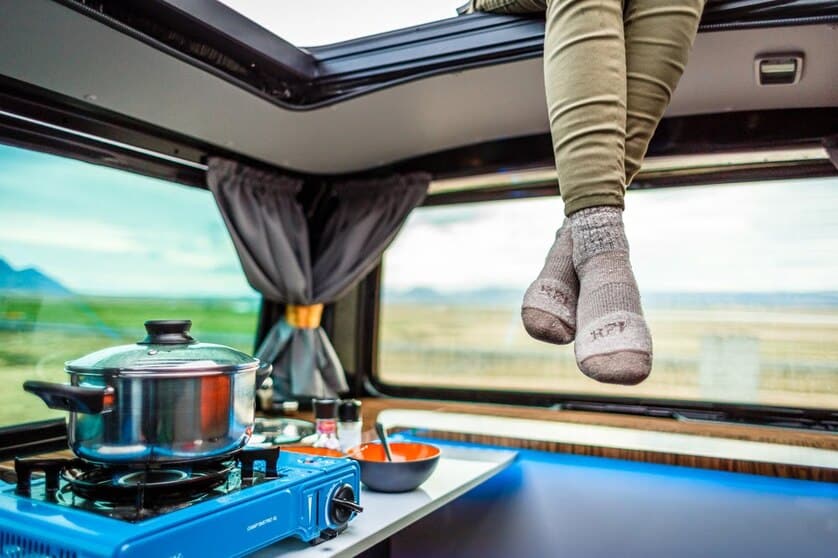As you prepare for an Iceland adventure, it’s crucial that you find and wear the right clothing. The proper clothing can guarantee a trip where you remain cozy, comfortable, and able to enjoy everything Iceland has to offer — from volcanic landscapes to glacial lagoons.
Iceland’s weather is famous for being unpredictable, so the trick to ensure that you don’t get uncomfortable is to have layers available. Versatile, weather-resistant gear that can handle sun, rain, snow, and wind will be your go-to choice for what to wear in Iceland.
Let’s dive into specific tips and advice straight from team of locals that will keep you cozy, after all keeping cozy is our specialty! That way, nothing can distract you from our beautiful landscapes.
What is the Best Clothing to Wear in Iceland?
Not so much the clothing itself, but the best way to wear it in Iceland is to layer. Icelandic weather can shift from warm and sunny to chilly and raining within the same day. Start with a base layer of thermal or moisture-wicking fabric, followed by a mid-layer (like fleece or down) to trap warmth.
Next, you will want something that is waterproof and windproof for an outer layer like a jacket, as this is another must-have for the unpredictable rain and wind gusts Iceland is known for.
Layering allows you to adjust as temperatures change, so you can always remove a layer if you feel too warm and add another when you feel cold, all without being bulky.
Let’s burrow in season by season so you can always be cozy no matter when you visit.
What to Wear in Iceland in Summer, (June, July, August)
Even during the summer months, Iceland does not exactly get hot. What to wear in Iceland in August or the other summer months may not be what you are familiar with. Temperatures in June, July and August average between 10-15°C (50-59°F). You can at least expect to see more sunshine and milder weather conditions when compared to other seasons.
Some suggestions on what to wear in Iceland in June, July and August include:
- Base layer – A moisture-wicking t-shirt under a long-sleeved top.
- Mid-layer: Fleece or down lightweight jacket for the cooler mornings and evenings.
- Outer Layer: Waterproof and windproof lightweight jacket that can protect against rain showers.
- Pants: A pair of quick-drying hiking pants are ideal, but, if you don’t have them a good pair of jeans can work—but keep in mind only for the less rugged areas, like in Reykjavik.
- Shoes: Waterproof hiking boots are the best bet, but sneakers can be suitable for Iceland’s cities and small-town streets if the weather is dry.
Surprisingly, another must-have item for what to wear in Iceland in July or the other summer months? An eye mask! Iceland in summer means experiencing the midnight sun, so if you are sensitive to light while sleeping, an eye mask will be something you need.
What to Wear in Iceland in September
In September, visitors will begin to be entranced by The Northern Lights, but they may not be fond of the nighttime chill. September is also the month that brings more rain, with average temps dipping to 7-12°C (45-54°F). Layering becomes more important during this month. We suggest:
- Base Layer: Moisture wicking long-sleeve shirts or thermals
- Mid-layer: Thicker fleece or a lightweight insulated jacket
- Outer layer: A good quality waterproof shell jacket
- Pants: Quick-dry hiking pants during these months will be more suited that slower-drying jeans
- Footwear: Waterproof hiking boots for any hike, trail, beach or off-the-beaten path attraction. Sneakers are suitable for dry days in cities and towns.
Our vans come equipped with blankets but feel free to pack a lightweight cozy thermal blanket for those nighttime Aurora watching sessions.

What to Wear in Iceland in October
October in Iceland brings another drop in temperatures and in some places, even snow. Temperature can average around 3-7°C (37-45°F). This month requires warm layers and good protection from icy winds. Consider:
- Base layer: Thermal underwear or moisture-wicking thermal long-sleeved shirts
- Mid-layer: Fleece and a warm down jacket
- Outer Layer: Reliable, good quality insulated waterproof jacket that will keep you warm and dry
- Pants: Insulated hiking pants or waterproof pants work best for any outdoor activities.
- Footwear: Waterproof hiking boots with excellent traction; sneakers will not be enough for cold and wet days.
Are Jeans a Good Choice for Iceland?
Yes and no. Jeans can work for Reykjavik or short city and town excursions when the weather is dry, but for any outdoor exploration and more rugged landscapes, jeans simply aren’t ideal. Denim doesn’t dry quickly if it gets wet, and wet clothing in cold temperatures can very quickly lead to discomfort or in the worst-case scenario it could lead to hypothermia!
What’s the Dress Code in Iceland?
You could say that our dress code is casual and functional. We locals value practicality over fashion, often wearing layered clothing with sturdy outerwear. Even in Reykjavik, you will notice we have a more relaxed style with comfortable jeans, sweaters and outer jackets.
When we dine out or visit our cultural sites, smart and casual attire is perfectly acceptable. Just leave your crampons, backpacks, and sweatpants behind if you decide to check out our nightlife in Reykjavik.
We Icelanders embrace practicality, so you can, too!
Clothing Packed? Your Island Adventure is Waiting!
Now that you are all set on what to wear, it’s time to hit the road and explore Iceland’s wonders in cozy style. Book your Cozy Camper today and take the ultimate Icelandic Road trip you won’t soon forget!
Comfortable, adaptable, and designed to embrace Iceland’s rugged and free beauty. We are ready to take you wherever your Icelandic dreams lead!
Back to blog